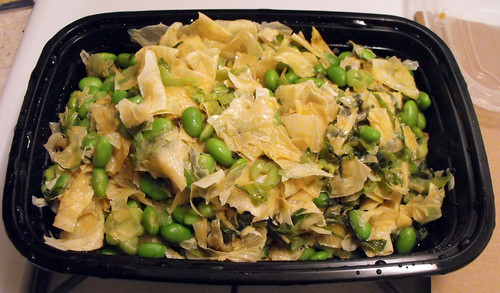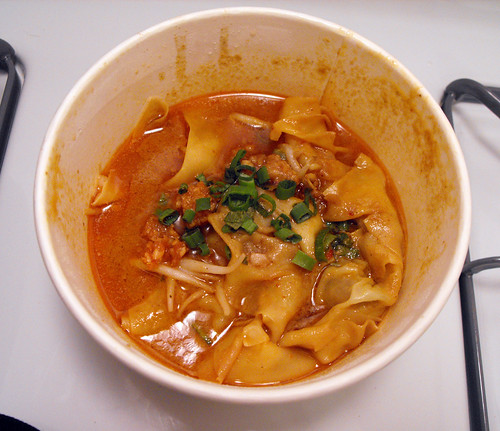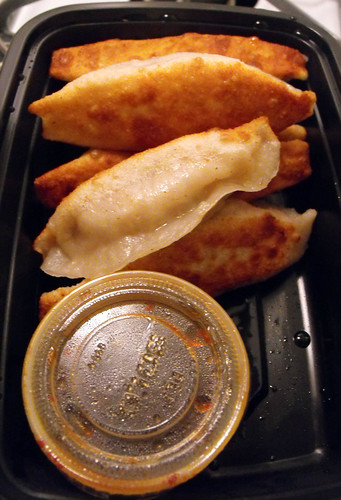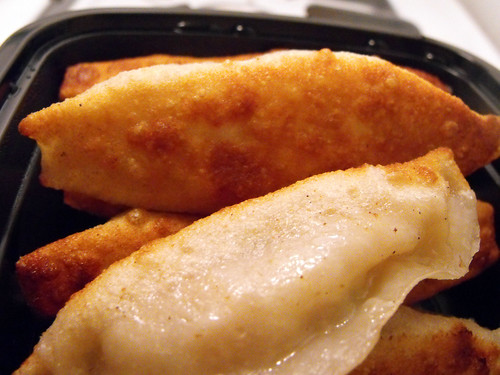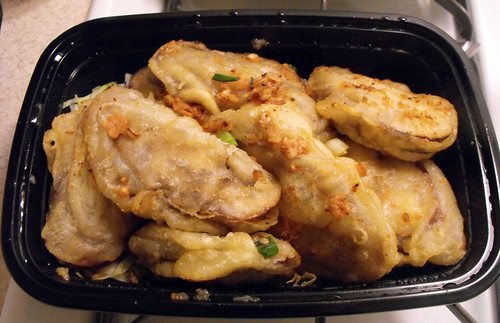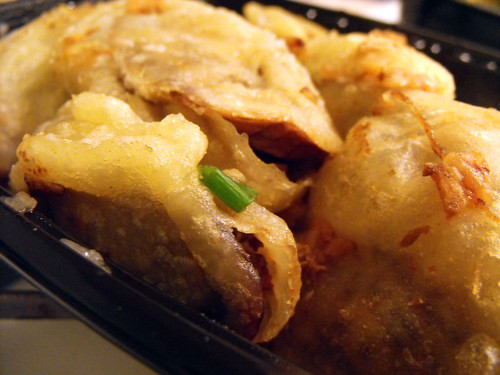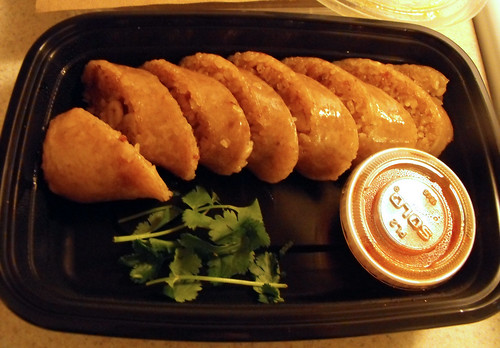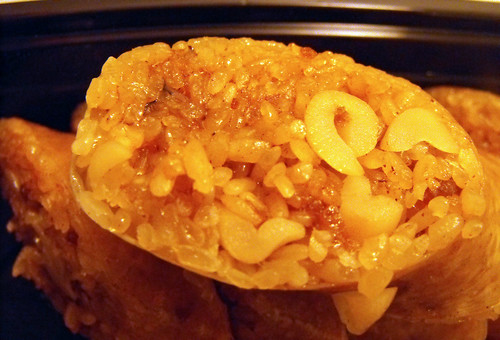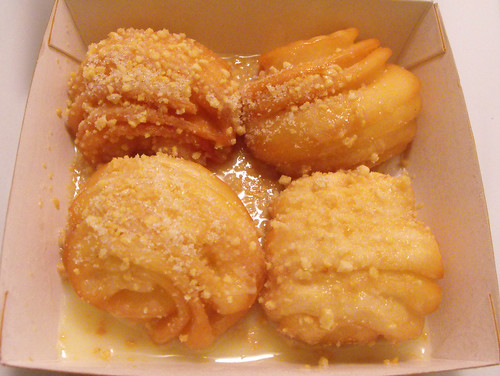This entry is about free stuff. Check out the free stuff policy here.
Marx Foods sent me three bottled citrus juices to play around with: yuzu, kabosu, and sudachi. I wanted to try sweet, savory, and cocktail applications with all three.
What I figured out pretty quickly is that the question here is not just "what can you do with these juices?" - it's "of the things you can do with these juices, which of them really show off the individual character of each juice?" And that list is much shorter. After all, even out of season it's pretty cheap to pick up some fresh lemons or limes - so there's no reason to use an expensive bottled juice in a dish where all you're going to taste is a little acidity. Just like you aren't going to put porcini mushrooms in chili, you don't want to use sudachi juice in a pitcher of punch with eleven other ingredients - it's not going to stand out.
Let's talk about the juices themselves first. Each of them, while more acidic than orange or grapefruit juice or anything else you'd drink a glass of, is noticeably less acidic than lemon or lime, and I had to correct the first things I made accordingly. I happen to have citric acid on hand - it's cheap enough, you can throw some in the dishwasher to make your dishes cleaner, and Amazon carries it - so it's easy for me to adjust acidity, and using citric acid to do so instead of lemon or lime juice preserves the original flavor. All of the desserts in particular benefit from a pinch of citric acid - it really brings out the flavors of the juice.
But I needed to try them straight, even if they're not meant to be drunk that way. A quick breakdown of the juices - first how the label describes them, then how they tasted to me.
Kabosu juice
label: "flavors and aroma of LEMON with accents of MINT and MELON"
me: a definite herbaceousness which I think is what they're calling mint - basil was what came to mind for me, though, because it certainly has none of the menthol of mint. I taste more navel orange than lemon, just tarter. This is the least tart of the three, to my palate - I didn't think to pick up pH papers to actually check acidity, but tartness is really the balance of acidity to sugar, I think, so a really objective measurement would have to measure Brix too. And I'm not picking up a refractometer.
Yuzu juice
label: "flavors and aroma of ORANGE, LEMON, and TANGERINE"
me: yuzu is really its own flavor. How would you describe lime, after all - "like lemon, but sharper"? The closest analogues to yuzu for me are lime and grapefruit, not orange or lemon. This is one of my favorite fruits - it's really terrific stuff.
Sudachi juice
label: "multiple flavors and aroma of LIME with accents of PEPPER and CUMIN"
me: I understand the pepper in the aroma, I guess, but I don't get cumin at all. Lime, though, yes. This is a less tart lime with something a little spicy and vegetal going on.
SWEETS
Kabosu bars

I made kabosu bars, for instance, using a regular lemon bar recipe, with about 25% more juice in order to really focus on the flavor. They were still too flat-flavored, so I included some citric acid in the confectioners sugar on top, and that did the trick.
Is it good? Yes.
Does the kabosu make a difference? Yes. You can definitely tell these aren't lemon bars.
Yuzu pie with huckleberries

A key lime pie - 1 can sweetened condensed milk, 3 egg yolks, and 3/4 cup juice blended together and baked for 20 minutes in a Graham cracker crust - with yuzu juice instead of key lime, a little citric acid added (critical when there's all that sweetened condensed milk), served with huckleberries on top.
Is it good? Absolutely delicious.
Does the yuzu make a difference? Hugely. You would easily be able to tell one citrus juice from another in side by side tasting, since nearly all the flavor comes from it.
Yuzu pudding cake

This type of pudding cake separates into two layers as it cooks - a light cake on top and a pudding underneath it. For some reason the top blackened very quickly, but doesn't taste it at all. I used yuzu juice and a hit of citric acid in place of the Meyer lemon juice called for in this epicurious recipe.
Is it good? Yes.
Does the yuzu make a difference? Less than in the pie, but yes, definitely.
COCKTAILS
All of the cocktails use a pinch of citric acid with the juice.
Hemingway daiquiri with yuzu

A Hemingway daiquiri has a little grapefruit juice and a little maraschino liqueur added to the standard daiquiri. I used yuzu juice and a touch of citric acid in place of the lime juice, and served with frozen grapefruit segments.
2 oz rum
.75 oz yuzu juice
1 teaspoon maraschino liqueur
1 teaspoon sugar
1 teaspoon grapefruit juice
Is it good? Pretty good but pretty sweet.
Does the yuzu make a difference? Somewhat. The maraschino drowns some of it out.
Kamiyama Bitter

I based this on the proportions of the bitters-heavy cocktails I make a lot, where cocktail bitters like Angostura or Peychaud's are used in place of a base liquor. Donn's Mix is a cinnamon-grapefruit syrup sold by Trader Tiki.
1 oz Ango orange
1 oz Trader Tiki's Donn's Mix
1 oz sudachi juice
1/2 oz blanco tequila
Is it good? It's not bad. It might be better with regular Angostura bitters.
Does the sudachi make a difference? No. There's a definite citrus flavor, but between the bitters and the cinnamon, you'd be hard pressed to identify this as sudachi instead of any other citrus.
Peacock Room

I've been wanting to play around with Pimms in things other than Pimms Cups, so this was a good opportunity. This is vaguely like a Corpse Reviver #2.
absinthe rinse
1 oz Pimms
1 oz yuzu juice
.75 oz Cocchi Americano
.75 oz gin
a couple Coca-Cola-infused cherries (optional)
Is it good? Yes. The spice of the Pimms works well with the Cocchi, the cherries, and the yuzu.
Does the yuzu make a difference? More than the daiquiri, so it's a step in the right direction - but not quite there yet.
Taketa Sour

I didn't want to combine maraschino with these juices again, so made something similar to a Last Word, with the more subtle St Germain instead of maraschino, dialed-down Chartreuse, and black raspberry infused mezcal.
1 oz St Germain
1 oz kabosu juice
.75 oz black raspberry infused mezcal
.5 oz Chartreuse
pinch citric acid
Is it good? It's quite, quite good. The best drink so far.
Does the kabosu make a difference? Yes and no. There's a definite pronounced citrus character despite the strength of the other flavors. I'm not sure it's notably different from what you would get from lime, though.
Kabosu gimlet

So I dialed it back to basics - focus everything around the juice.
1.5 oz gin
1 oz kabosu juice
.75 oz simple syrup
.5 oz douglas fir eau de vie
Is it good? Yes.
Does the kabosu make a difference? Yes. You're definitely tasting kabosu here, not sudachi, not yuzu, not lime or lemon.
SAVORIES
Sudachi Faux-Dobo

Marinate chicken in 1/2 cup sudachi juice, 1/4 cup soy sauce, tablespoon pepper vinegar; bake until very well cooked, transfer to stove top, add 1/4 cup sugar.
The idea here is to make something similar to adobo - vinegar and soy sauce - but with citrus juice. There's no added citric acid here.
Is it good? Yes. The sauce is the perfect offset to the richness of chicken thigh and the gelatinousness of long-cooked chicken wings.
Does the sudachi make a difference? More than I thought it would. Adding too many other ingredients - the garlic, peppercorns, and bay leaves traditionally used in adobo - would have muddied the waters too much.
Sudachi chicken and potatoes

This is kind of fiddly.
Brown a stick of butter: simply heat it until it foams, stops foaming, and there are a lot of visible brown solids. Let cool somewhat.
Blend the brown butter with 6 peppadews, 3 garlic cloves, 1/4 cup of sudachi juice, and 1 cup of chicken broth.
Bake chicken in the resulting sauce for at least an hour (at about 375-400), until the sauce has visibly reduced. Remove the chicken, add small whole potatoes to the broth, and cook for another hour so that the potatoes soak up the sauce. Transfer chicken, potatoes, and sauce to a larger shallow pan and cook for an additional half hour in order to crisp everything up.
Is it good? Yes. Rich, with the slight spice of the peppadews and the tartness of the juice offsetting the richness.
Does the sudachi make a difference? It's not entirely lost but would be no worse with lemon.
Kabosu Fried Chicken


Make a sauce of about 2 parts Kabosu juice to 1 part Korean red pepper paste, with a little bit (1-2 Tablespoons) of brown butter, a litle sugar, and a little cornstarch dissolved in cold water. Heat the sauce until it thickens.
Lightly bread and fry pieces of chicken and then toss them in the sauce.
Is it good? It's delicious - spicy, tart, and sweet. Awesome junk food/bar food.
Does the kabosu make a difference? Yes, although the spicier you make it, the less you will notice the specific citrus characteristics.
Spicy cod with kabosu

Stir-fry together sliced Korean green chiles (mild to medium), grated ginger, soaked and crushed fermented black beans or storebought black bean sauce, a little Thai chile paste, a little cornstarch dissolved in cold water, and a few tablespoons of kabosu juice until the sauce is noticeably tart.
Sear chunks of cod and then add them to the sauce to finish cooking. Serve with rice.
Is it good? Very tasty.
Does the kabosu make a difference? Not really - any source of acidity would be the same.
INCIDENTAL USES

Mango slices with kabosu juice and black sesame seeds.
You can use the juice as a condiment by itself, of course - sprinkling it on fried fish, raw greens, cucumber and onion, kimchi and sesame seeds, fresh fruit, and so on. You can also use it in vinaigrettes. However, unless you're serving it with something very bland - a simple green salad, maybe - you're not going to pick up many flavor specifics. While this is one of the most common uses of these juices in Japan - as well as in ponzu sauce, yuzu juice with soy sauce - the fruits are also cheaper there.
They'll come forward better added to tea. I didn't think lemonade-type drinks quite worked - the flavor seemed too diluted.
All in all, what are these juices best for? I would definitely make the faux-dobo again, which was not only one of the tastiest things I made but something that showed off the flavor well. Cocktails that really focus on a citrus juice as the main flavor - such as a whiskey sour, gimlet, or sidecar - all work well, but any more complicated flavors will drown out the nuance. And desserts work well across the board.
Bottled vs Fresh. I've never had fresh kabosu, but I've had fresh sudachi and fresh yuzu several times and cooked with them extensively. Is there a difference? Sure. It's similar to the difference between fresh lemon juice and a good bottled brand, though more care seems to be taken here than with most supermarket lemon juice. You do lose some flavors because you get none of the oil or the flavor compounds that disappear with age - but you're still getting real yuzu and sudachi flavor, not some imitation extract. I noticed no real difference in the desserts between the fresh and the bottled. The difference is only really notable in beverages - cocktails and tea. Even so, fresh yuzu is hard to find, only available for a brief part of the year, and costs a lot - as compromises go, bottled yuzu juice is a good one.

























